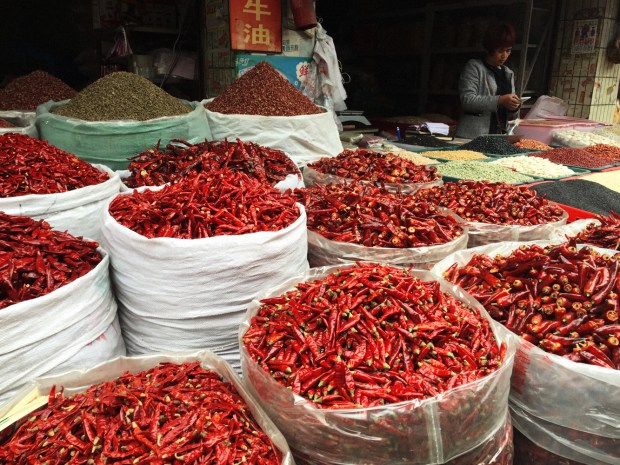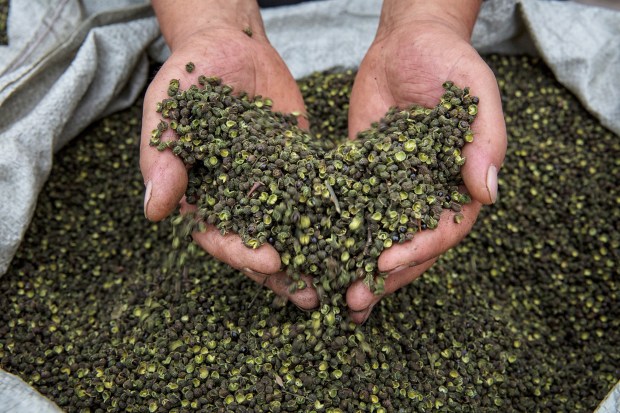In China, Sichuan food is known for
its complex and sophisticated canon of tastes. In the West, it’s
invariably known for only a few dishes and face-melting heat and spice—a
reputation that grossly underestimates the cuisine.
To understand Sichuan food one must understand its history and geography. The Sichuan basin is flanked by mountains on all sides and the vast Qinghai-Tibet plateau to the west, making it so difficult to reach that the Tang Dynasty poet Li Bai described getting there as “more difficult than the road to heaven.” But its fertile plains lured many onto the journey, and dynastic upheavals over the last few thousand years have drawn continuous waves of immigrants into the province. Each wave brought along its own culinary and cultural customs.
For thousands of years, Sichuan was known as “the land of plenty” (天府之国 tianfuzhiguo). Its warm, wet climate and fertile plains created agricultural abundance. That harvest potential increased in the third century B.C. with the completion of the massive and sophisticated Dujiangyan Irrigation Project, which harnessed the power of Sichuan’s many rivers. The region became the bread basket of China, contributing to unification efforts under emperor Qin Shihuang.
Located along the Silk Road and Tea Horse Road, major trade routes to the West, Sichuan absorbed many outside influences into its culture and culinary practices, most notably the adoption of chili peppers from South America and cooking techniques from northern and eastern parts of China.
To understand Sichuan food one must understand its history and geography. The Sichuan basin is flanked by mountains on all sides and the vast Qinghai-Tibet plateau to the west, making it so difficult to reach that the Tang Dynasty poet Li Bai described getting there as “more difficult than the road to heaven.” But its fertile plains lured many onto the journey, and dynastic upheavals over the last few thousand years have drawn continuous waves of immigrants into the province. Each wave brought along its own culinary and cultural customs.
For thousands of years, Sichuan was known as “the land of plenty” (天府之国 tianfuzhiguo). Its warm, wet climate and fertile plains created agricultural abundance. That harvest potential increased in the third century B.C. with the completion of the massive and sophisticated Dujiangyan Irrigation Project, which harnessed the power of Sichuan’s many rivers. The region became the bread basket of China, contributing to unification efforts under emperor Qin Shihuang.
Located along the Silk Road and Tea Horse Road, major trade routes to the West, Sichuan absorbed many outside influences into its culture and culinary practices, most notably the adoption of chili peppers from South America and cooking techniques from northern and eastern parts of China.

辣椒 Chilies
Sichuan people’s love of spice can be attributed to the region’s muggy climate. According to principles of traditional Chinese medicine, dampness creates imbalance in the body and must be driven out by eating foods that are “heating” in nature. In the early days, the heat came not from chilies but from a combination of ginger, Sichuan pepper, and cornel berries, the ruby red fruit of the cornus mas plant. These aromatics comprise the 辛辣 xin la, or pungent spice flavor, that is valued by Sichuan chefs over the pure fiery heat more commonly associated with Hunan and Guizhou cuisines. It was not until the 16th century that chili peppers arrived in coastal China via maritime trade routes, and not until centuries later that they were cultivated in Sichuan. Locals adopted chilies as they discovered their perfect harmony with the aromatic numb of Sichuan pepper, and they became an integral part of the cuisine.二荆条 Erjingtiao, the most popular variety of chili in Sichuan, is known for its mild spice but intense fragrance. It doesn’t overwhelm the taste of a dish but instead heightens sensations and awakens the palate to deeper flavors. Its uses are varied and inventive: dry-fried in oil for a scorched-chili flavor; fermented with fava beans for Sichuan’s famous doubanjiang; pickled to lend acidity to fish-fragrant sauce; ground up and combined with aromatics to create the canvas for the most fragrant chili oil; and mixed with various other spices to make dozens of Sichuan flavor profiles from mala (spicy and numbing) to guaiwei (strange flavor), a perfect balance of sweet, savory, spicy, sour, and numbing.
符合味 Compound Flavors
Not all of the region’s flavor profiles are spicy. Sichuan chefs are famous for combining a limited number of ingredients to form at least 24 compound flavors known as fu he wei. Of these, only about seven feature the spiciness famously associated with Sichuan cuisine. Lesser known but just as iconic, 椒盐味型 jiaoyanweixing (salt–and–Sichuan pepper flavor) is a deceptively simple combination of roasted ground Sichuan pepper and salt but is inventively applied on everything from fried chicken to freshly baked butter cookies. “Lychee flavor” has no lychees in it but combines sweet and sour notes in imitation of the fruit and is applied to a savory canvas like fried pork over rice. What unifies all of 24 flavors is a complex 鲜 xian (umami) quality and a strong, pungent flavor that is not meant to overshadow the natural taste of the raw ingredients but rather to delicately draw out their essence.
花椒 Huajiao
An ancient Chinese spice that has been cultivated in Sichuan for thousands of years, huajiao (Sichuan pepper) is responsible for the cuisine’s famous tongue-tingling sensation. Some believe its use in Sichuan cooking is to numb the senses enough to allow one to eat even more chilies. Huajiao is actually the seed of a tree in the citrus family and isn’t related to the common peppercorn, leading to a decades-long ban in the U.S. out of fear that it would cause citrus cankers. The ban was later dropped but with the caveat that huajiao had to be heat-treated before export, a condition that very few producers have accepted. For these reasons, as well as low demand, the packages of long-expired huajiao sitting on grocery shelves in the West are vastly inferior to the real thing.There are dozens of varieties of huajiao in China, but the most famous is grown in Qingxi village, along the mountainous Tea Horse Road, an ancient trading route dedicated to the transport of tea and spices from China to the West. The small village produces a variety known as 贡椒 gongjiao (tribute pepper), so prized for its many medicinal and culinary uses that it was offered in tribute to the emperor. The delicate kernels are painstakingly hand-harvested every August in small quantities and sell out almost immediately. Thrown whole into long braises and stews or roasted and ground to top iconic dishes like mapo tofu and twice-cooked pork, just-harvested gongjiao can be transformational.
No comments:
Post a Comment